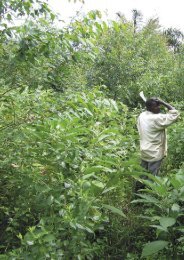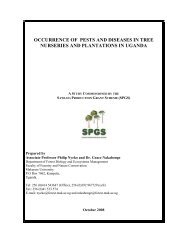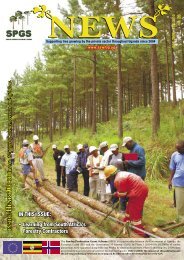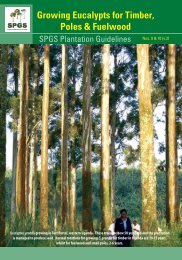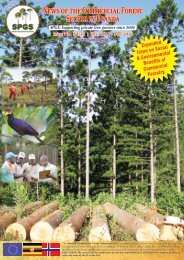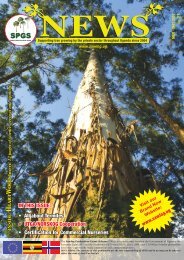Create successful ePaper yourself
Turn your PDF publications into a flip-book with our unique Google optimized e-Paper software.
HeartWood No. 6 (2010)<br />
Institute (FABI) - entitled Forest Tree Health<br />
in South Africa: Looking Back and Looking<br />
Forward. He notes that over the last 20 years<br />
the major threat has been the accidental<br />
introduction of new pests and pathogens<br />
and cites the examples of pitch canker<br />
fungus (Fusarium circinatum) and insect<br />
pests such as the Sirex wood wasp (Sirex<br />
noctilio) and the bronze bug (Thaumastocoris<br />
peregrinus). The author offers some good<br />
advice:<br />
“The reality that insect pests and<br />
pathogens seriously threaten the<br />
future of plantation forestry is now<br />
well established. Recognizing the<br />
enemies and understanding their<br />
modes of action represent the most<br />
important steps towards their<br />
management and control”.<br />
So no ‘silver bullet’ solution it seems: we just have<br />
to do the research and ensure sound management<br />
practices to reduce the incidence of current and<br />
potential threats to our trees - Ed.<br />
Staying with pests and diseases (they<br />
just won’t go away easily!), there is also<br />
a report in the same journal on the 20th<br />
Annual Meeting of the Tree Protection<br />
Co-operative Programme (TPCP), held<br />
in Pretoria in May, 2010. Investors are<br />
increasingly worried by the susceptibility<br />
of P. patula to Fusarium, with ca.40% of P.<br />
patula plants coming from nurseries being<br />
infected. A key strategy being adopted<br />
by York Timbers (one of SA’s major<br />
commercial forestry companies) is to<br />
breeding hybrid pines more resistant to<br />
Fusarium - e.g. P. patula x P. tecunumanii. To<br />
subscribe to SA Forestry see<br />
www.saforestrymagazine.co.za<br />
ARBOR VITAE<br />
This well produced publication is always<br />
an interesting read and even though<br />
it is largely concerfned with natural<br />
forest management and conservation,<br />
it frequently has articles of relevance to<br />
us plantation wallas. It is IUCN’s Forest<br />
Conservation Programme Newsletter<br />
and is available free from www.iucn.org/<br />
forest/ The most recent edition (Issue 41<br />
– June 2010) focuses on Forest Finance; No.<br />
40 featured Forests and Climate Change.<br />
CHARTERED<br />
FORESTERS<br />
We were impressed by the Institute<br />
of Chartered Foresters’ (ICF) stand at<br />
Edinburgh. ICF is the UK’s professional<br />
body of foresters and arboriculturalists. It<br />
is interesting to read how ICF are driving<br />
the profession forward: something we<br />
could certainly aspire to in Uganda, with<br />
the public’s perception of most foresters<br />
probably at an all time low. See www.<br />
chartered foresters.org/<br />
FORESTRY<br />
Forestry is a scientific publication<br />
published five times per year on behalf<br />
of ICF (see previous entry). The sample<br />
we were given by Oxford University Press<br />
at the Edinburgh conference (Vol. 83 No.<br />
1 (2010), contains an interesting article<br />
which reflects the way plantation forestry<br />
is changing in the UK – The effects of<br />
transformation of even-aged stands to continuous<br />
cover forestry on conifer wood quality and wood<br />
properties in the UK by Macdonald et al.<br />
FUELWOOD<br />
The question “Friend or foe?” came to<br />
mind when reading an abstract from a<br />
paper entitled: Evaluation of Prosopis juliflora<br />
properties as an alternative to wood shortage<br />
in Kenya by Sirmah et al (Bois et Forets<br />
des Tropiques 298; No. 4). The authors<br />
conclude that the wood from P. juliflora<br />
(known in USA as Mesquite) can be a<br />
valuable alternative source of fuelwood<br />
and construction timber in Kenya. Some<br />
people, however, see this species as a<br />
terrible weed that has invaded pasture<br />
land (it was rated amongst the world’s top<br />
100 worst invasive alien species by IUCN<br />
in 2004 - see www.worldagroforestry.<br />
org/). Whichever side of the fence one<br />
sits, the lesson is to be very careful before<br />
introducing new species into a region.<br />
Thanks to NORSKOG’s Campbell Day for<br />
forwarding this to us - Ed.<br />
EUCALYPT PESTS<br />
For those of you who haven’t yet received<br />
your copy of the International Journal of<br />
Pest Management (Vo. 65. No. 2, April-<br />
June 2010), Makerere University’s Philip<br />
Nyeko et al have just published a highly<br />
relevant paper in it - namely: Variations<br />
in Leptocybe invasa population density and<br />
infestation on eucalyptus germplasms in Kenya and<br />
Uganda. L. invasa is the Blue Gum Chalcid<br />
or Chalcid wasp that was first reported in<br />
Uganda and Kenya in 2002 and is now<br />
found on many of Uganda’s eucalypts.<br />
They studied the pest populations across<br />
many sites and on different species. There<br />
were some interesting conclusions to their<br />
study:<br />
• There were significant differences<br />
between population levels between sites<br />
and between neighbouring trees of the<br />
same species or provenance.<br />
• The incidence of L. invasa infestation<br />
peaked around 10-15 months after<br />
planting.<br />
• L. invasa adults were observed throughout<br />
the year in the study, indicating<br />
overlapping generations since the adults<br />
are known to live less than 7 days.<br />
• Of all the eucalypts studied, only E.<br />
henryi and two GC clones (GC581 and<br />
GC 578) showed complete resistance to<br />
L. invasa.<br />
Send us your articles<br />
or reviews on any topic<br />
of relevance to tree<br />
planting in Uganda<br />
“Learn from each other’s<br />
experiences. There is no<br />
need to make the same<br />
mistakes as the past”<br />
P.O Box 5244 Kampala.<br />
Plot 92 Luthuli Avenue,Bugolobi,<br />
Kampala.<br />
Tel. 0312 265 332/3.<br />
Fax. 0312-265 334.<br />
Email info@sawlog.ug<br />
www.sawlog.ug<br />
12



